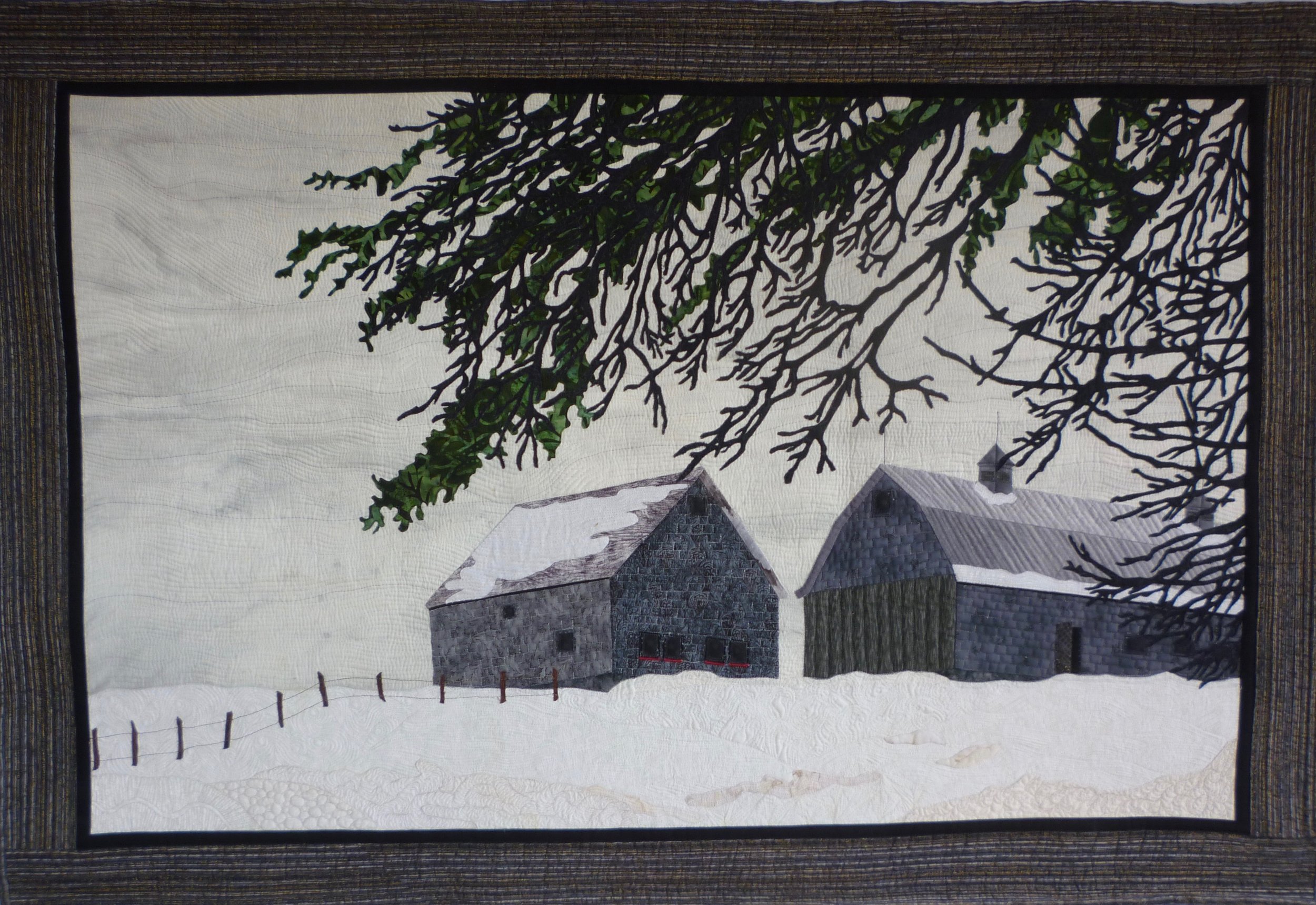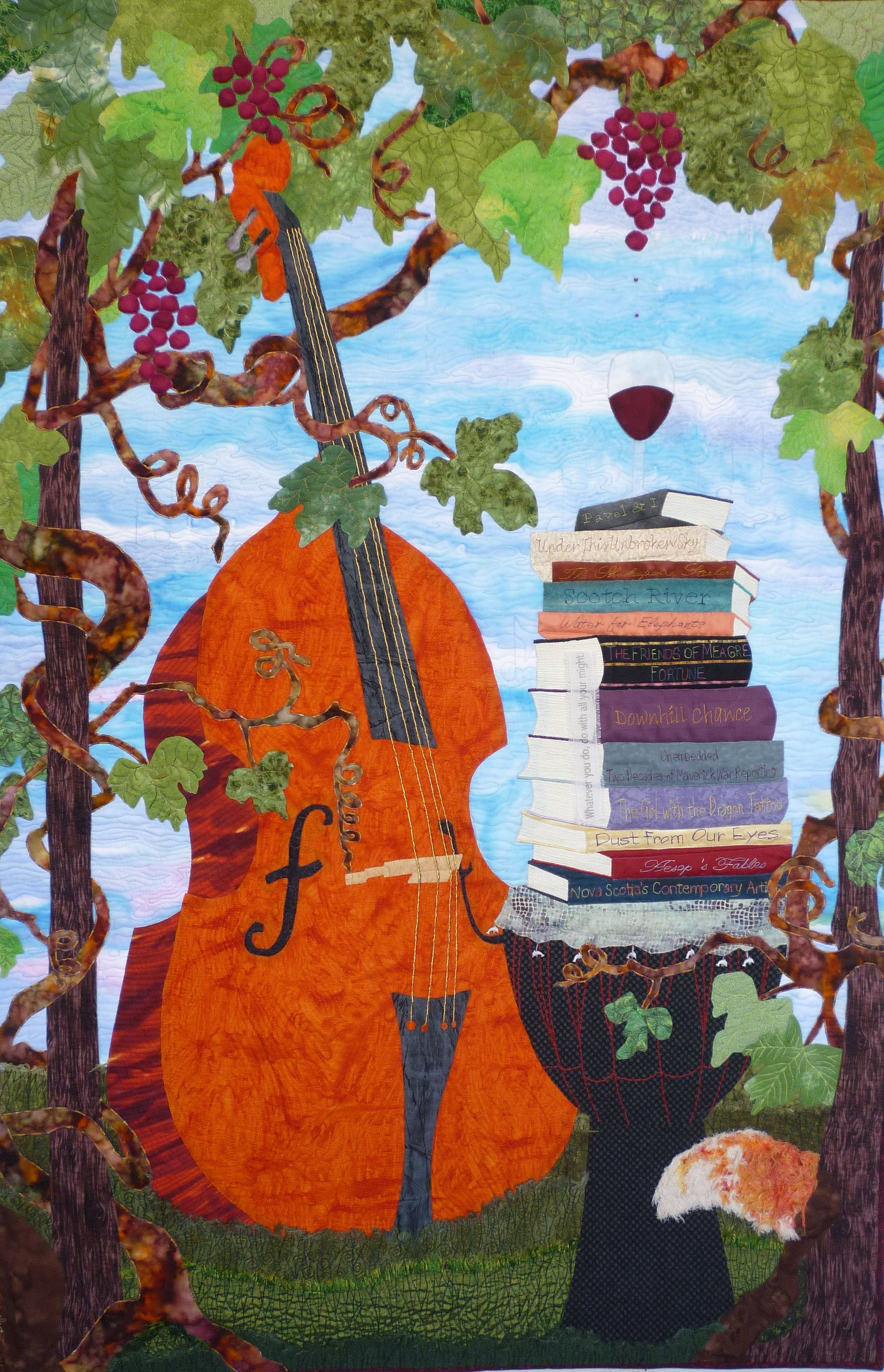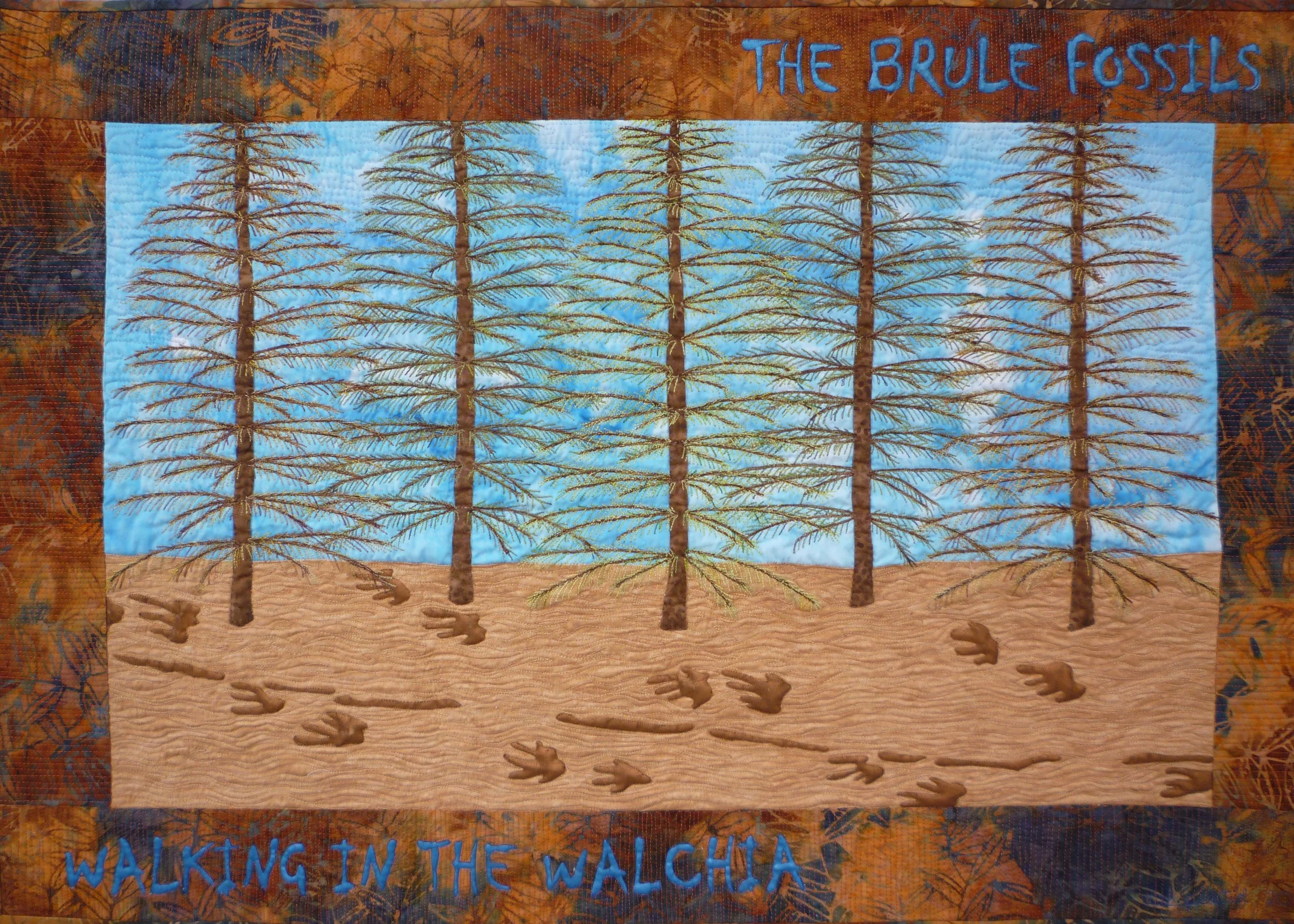-

MacKay Barns Imagined
In the winter months, the MacKay barns are imposing, weathered, grey structures set against a steel grey sky on a snow covered field. I imagine them in their early days boldly boasting their colour against a Spiddle Hill sunset. The barns were built in the community of The Falls, Nova Scotia near Spiddle Hill. Since 1834 these lands have been owned and occupied by seven generations of the MacKay family. The family were primarily dairy farmers, in 1938 the smaller barn was moved adjacent to the larger barn. This 214 acre farm is now home to Billy MacKay and his horses. These two silent sentinels are emblematic libraries - symbolic bears of knowledge, memory, optimism and cooperation. They bear witness to skills now seldom practiced, to innovation, industriousness and self-sufficiency; where form followed function and barns were built from readily available timber and stone. Look at the space between the barns and therein discover the why/y of farming.
42 x 30 inches
$4,000.00
-

Winter at Balmoral II
“Mon pays, ce n’est pas un pays, c’est l’hiver.
My country is not a country, it’s winter.”
Gilles Vigneault
Crisp, clear, cold, woefully underrated, wonderful white winter.62 x 41 inches
$8,000.00
-

Balmoral Grist Mill
Tucked away in a wooded gorge on Matheson’s Brook at Balmoral Mills, Nova Scotia, is a three storey grist mill where wheat, oats and buckwheat are ground on granite stones and sifted, as they have been since Alexander McKay opened the mill in 1874.In early fall, after months of warm, dry weather, the brook no longer flows over the dam. At this time the mill has a particular splendor, especially when it is backlit by rich afternoon light filtered through the tree canopy. In this quilt I highlight the disparate elements that I like most – the eroding stone foundations, the mill wheel, the weathered logs of the dam and bridge, all overlaid by the ghostly shape of a granite millstone. Through this quilt I pay homage to a remarkable historical structure and to the people who have been part of it.
61 x 40 inches
$10,00.00
-

Tantramar Marsh
The Chignecto isthmus is the narrow bridge of land that ties Nova Scotia to New Brunswick. The salt marshes, this place between the tides, made of both land and water, is an ecosystem dominated by grasses and flooded repeatedly by saltwater tidal flows. Acadian settlers, in agreement with the Mi’kmaq, constructed dykes in the salt marshes to hold back the high Bay of Fundy tides. The slowly disappearing Tantramar hay barns are a reminder of the once great salt marsh farms. Acadians inhabited Acadie from the 1600s to 1755 when they were expelled by the British.
51 x 35 inches
$5,500.00
-

Golden Spiral
A line . . . a curve . . . a number . . . and within the Fibonacci whole number sequence (1,1,2,3,5,8,13,21,…) the shape borrowed from nature is most ingeniously and marvelously articulated. An abstraction of cold, mechanical numbers cannot hope to capture the grand, limitless beauty of art in the natural world that reveals itself in this piece in the swirl of a seashell. A sacred connection is made, patterns are discerned and a world of meaning is discovered. You’ll find the golden spiral in the nautilus shell, fiddlehead ferns, the growth of sunflower seed heads, a ram’s horns . . .
51 x 51 inches
$8,000.00
-

Walls Long Gone
In the solitude of this Acadian forest, there still stands, in this chimney, a staggering example of the fortitude, ingenuity and fine handcraft of pioneers who came to Nova Scotia in the early 1800’s to build a life.
From 1838 until 1956, four generations of the McKay family lived nearby – never knew what it was to have electrical power, kept their butter cool in the stream under the sugar maples – and we came to build a life here. Beside the water hand-pump, hidden beneath the alder, red maple and iron birch trees was a hole in the ground. In the 1960’s, the house that stood here burned. Stones were all that remained – stone steps into a stone house foundation, the crumbling remains of a stone hearth and on the ground, the stones that had formed the chimney that kept the families who resided here warm.
Heart – hearth; the difference but a single letter. Post and beam homes were built with the timbers cleared to create fields. The walls will fall yet the heart and hearth remain. The stone hearth/heart survives to inform us about what once was, what stood here and offers reminders of a life left behind.42 x 57 inches
$8,000.00
-

A Seashell's Spell
Canada from sea to sea to sea - a magnificent seashell seen from the front, back and side, the traditional snail’s trail quilt pattern and the dramatic, wondrous beauty found in the bones of the nautilus shell -the spell of this biomimetic structure displays its magical and magisterial design and is common, plentiful on the shores of the Northumberland Strait in northern Nova Scotia.
30 x 40 inches
$3,600.00
-

Elephants and Far East Kaledioscope
A fabric kaleidoscope made based on Paula Nadelstern’s innovative, precise piecing and techniques.
38 x 38 inches
$2,500.00
In Private Collections
-

The MacKay Barns Standing Still on Spiddle Hill
Still standing, standing still; the MacKay barns were built in the community of The Falls, Nova Scotia near Spiddle Hill. Since 1834, these lands have been owned and occupied by seven generations of the MacKay family. The MacKay family were primarily dairy farmers, in 1938 the smaller barn was moved adjacent to the larger barn. This 214 acre farm is now home to Billy MacKay and his horses. These two silent sentinels are emblematic libraries - symbolic bearers of knowledge, memory, optimism and cooperation. They bear witness to skills now seldom practiced; to innovation, industriousness and self sufficiency; where form followed function and barns were built from timber and stone, the readily available materials. Look at the space between the barns and therein discover the why/“y” of farming.
-

Fables
Fables … a short moral story often with animal characters…a story about mythical/supernatural beings or events…a legend; the fables of gods and heroes…a story not founded on fact, an untruth; falsehood…the plot of an epic, a dramatic poem, or a play….idle talk; old wives’ fables.
-

Endicott Johnson
In the small community of Balmoral Mills lived siblings who spent many summers on the Matheson Brook Road family homestead. In 2010, the lands were sold. Inside an outbuilding these worn, mouse chewed boots, belonging to their father and made by the Endicott Johnson company, were found.
In 1912, the Endicott Johnson company was the only shoe company in the world operating independent of the hide and leather trusts and were thus able to make affordable shoes. -

Fiddleheads
A blueprint for spring, a green delicacy found on riverbanks needing only the sun’s warmth to expose a structure of immense complexity hidden in the fiddlehead, each compact spiral unfurls to become a fern of intricate design.
-

Swallows and Oak
A love of swallows inspires the construction dozens of swallow boxes and a love of oak trees galvanizes the planting of hundreds of acorns.
-

Guardian Mayflies
On an increasingly fragile planet, the earth struggles to sustain all living things. We are entrusted with protecting the stability and longevity of a nurturing earth. In the grand scheme of things, our lives are no more or less important than those of lowly insects. The earth has cradled mayflies for 180 million years ~ may they guard the earth for millions more.
-

The Brule Fossils - Walking in the Walchia
The Brule fossil site is less than 1/4 acre located in the inter-tidal zone on the beach at Brule on Nova Scotia’s north shore. In 1994, brothers Cory and Howard van Allen discovered the remains of Walchia tree stumps in rocks that were exposed by the retreating tidal waters of the Northumberland Strait. They found fossil stumps, branches, foliage, fallen trunks and astonishingly footprints preserved between the trunks.
The walchia, now extinct, was a conifer very similar in appearance to the Norfolk Island pine that flourished about 290 million years ago during the Permian period. The Brule find is the only known in situ stand of Walchia trees in the world.
The Brule fossil site contains a prolific record of tetrapod tracks. Five different animal prints have been identified. The fossilized tracks became exposed on the beach as erosion occurred downward through the surface layers. The trackways of the Seymouria is the earliest record of group behaviour among tetrapods in the world. -

Dragonfly Pond
Class – insecta
Order – odonata
Family – aeschnidae
Genus & Species - anax imperator Dragonflies are ancient beings that have remained virtually unchanged for 230 million years. The fastest flying of all insects, the carnivorous dragonfly catches insects on the wing. Their territory is always over a freshwater pond or lake. Dragonflies are extremely susceptible to the effects of water pollution, their future and very survival depends on clean, uncontaminated water. This regal insect is lionized here in exuberant colour and exaggerated size. -

Heather's Wood
Heather’s Wood celebrates a 25-year friendship and the rich and dynamic tapestry that is biodiversity in an early morning woodland. A snake slips among the ferns while dragonflies, swallowtail and red admiral butterflies flitter in the oaks.
-

East River Bay
For whatever we lose (like a you or a me)
It’s always our self we find in the sea.
e.e. cummings
Water is the most abundant compound on the earth’s surface, covering 70% of the planet. Essential for all life on earth - it makes up 55% to 78% of the human body. A symbol of purity, rebirth and healing, water is honoured by ancient civilizations - Ganga river goddess - Neptune lord of the sea - Sabawalenu Mi’kmaq water spirit - Nammu goddess of the primordial sea.
The cure for anything is salt water - sweat, tears or the sea.
Isak Dinesen -

DNA Daughters
For my daughters whose matrilineal lineage is connected to the cultures of France, Ireland, Scotland and England, and in Canada to the French, English and Acadian cultures of Quebec and Prince Edward Island. The eleven generations of women are named on the DNA bars, the beads beside each name denote the generation to which the women belong. The duality of my daughter’s identities is reflected in the double DNA strand. The strand is set against the definition of feminism and matrilineality in both of Canada’s official languages.
-

Stinkbug
stink bug
a nuisance bug
mythologically, the stink bug is symbolic of the connections between seemingly unrelated events,
it represents intuition & sensitivity to what is hidden
and one’s ability to read between the lines -

Rauga Bee
rauga/yeast/leaven - saccharomycotina fungus, ascomycota yeast and represented by the mycelium web; to permeate, modify or transform for the better…
bee - symbol of the soul; messenger to the divine, with its ability to fly between the worlds of heaven and earth; royal emblem signifying immortality and resurrection…
Gracious words are a honeycomb, sweet to the soul and healing to the bones - proverbs 16:24 -

In Silent Flight
Strix varia, most commonly known as barred owl (in Quebec, le chat-huant du Nord) is found in Canada, from British Columbia through to Nova Scotia. In silent flight, the elusive, haunting, nocturnal barred owl perches outside on a winter branch, at home in the night sky and in Amara’s dreams outside her window.
-

At the End of the Day
Calm follows the slow halcyon descent of the sun. A gentle and forgiving earth encourages introspection and appreciation as we end our day observing illuminated and scraggly field weeds.
-

Three Bums on a Beach
Three bums enjoying a warm day at Fox River, Nova Scotia.
-

Moonlit Morning Glories
Morning glories entwine and climb anything on which they can take hold. When you look closely, you’ll spy a spider’s web spun in the most delicate of places. Imagine the night time reflections of the moon on a diaphanous cobweb and locate the spider living there.
Three things in human life are important.
The first is to be kind.
The second is to be kind.
And the third is to be kind.
Henry James
Photo credit - Sarah Baker Forward
https://www.instagram.com/sarah.bakerforward/
